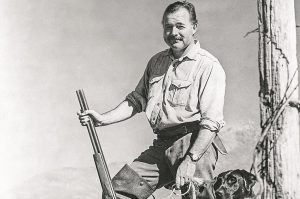Ernest Hemingway remains one of the most influential writers of the 20th century, celebrated for his concise prose, psychological insight, and vivid atmospheres. One of the most striking features of his work is the interplay between his personal experiences and the fictional worlds he created. Many of his novels and short stories are infused with events drawn directly from his own life—ranging from military service, hunting, and travels to personal relationships and emotional struggles. Understanding these autobiographical motifs provides a deeper comprehension of Hemingway’s literary aims and allows readers to appreciate how his experiences shaped his distinctive style, themes, and characters.
Hemingway himself often described writing as a form of personal exploration. He observed life closely and translated even ordinary experiences into rich narrative material. Unlike many authors who used imagination alone, Hemingway’s fiction is rooted in the realities he lived, providing both authenticity and emotional resonance. The result is a body of work where the personal and literary intertwine, revealing insights about human endurance, moral complexity, and the subtle interplay of external events with internal emotion.

War and Trauma: From Personal Experience to Literary Portrayal
One of the most prominent autobiographical motifs in Hemingway’s writing is his experience in war. Serving on the Italian front during World War I, Hemingway was assigned to drive ambulances, evacuating the wounded from dangerous battle zones. During one mission, he was severely injured, an experience that left lasting physical and psychological marks. This real-life exposure to the chaos, fear, and suffering of war became central to his fiction, most notably in A Farewell to Arms and For Whom the Bell Tolls.
In these works, the depiction of battle is highly realistic. Hemingway captures the sensory details of war—the roar of artillery, the smell of gunpowder, the confusion of the battlefield—without resorting to melodrama. His protagonists experience both physical danger and moral uncertainty, facing life-or-death situations while maintaining a quiet, controlled resilience. This blend of realism and understated emotional depth is characteristic of Hemingway’s “iceberg theory”: most of the meaning lies beneath the surface, leaving readers to sense the unspoken tension and emotional weight.
The war motif also allows Hemingway to explore broader themes. Courage, honor, fear, and loss are all central to his characters’ development. Soldiers confront not only external threats but also internal moral dilemmas, often navigating a world where conventional codes of conduct seem inadequate. The author’s personal trauma informs these portrayals, lending authenticity and emotional intensity. Readers can feel the weariness of soldiers, their fleeting moments of joy, and their profound losses, because Hemingway experienced and processed these realities firsthand.
Moreover, the theme of trauma in Hemingway’s war narratives extends beyond battlefield experiences. Characters frequently struggle with long-term psychological effects, reflecting Hemingway’s understanding of how combat alters human perception, emotional regulation, and relationships. This exploration of psychological realism was innovative at the time and contributed significantly to his lasting literary impact.
Hunting, Adventure, and Travel as Sources of Symbolism and Character
Beyond the battlefield, Hemingway’s love for hunting, fishing, and global travel constitutes another significant autobiographical motif. His time spent on safaris in Africa, fishing expeditions in Cuba, and various hunting trips across Europe is reflected in works such as The Old Man and the Sea, Green Hills of Africa, and numerous short stories. Nature and adventure serve as more than mere backdrops; they become symbolic arenas where characters confront challenges, test endurance, and demonstrate personal values.
In The Old Man and the Sea, for instance, the struggle between Santiago and the marlin exemplifies both a literal and metaphorical confrontation. The physical exertion, patience, and careful strategy required in the hunt mirror inner conflicts, including pride, perseverance, and the human confrontation with mortality. Hemingway’s own experiences at sea, catching fish under challenging conditions, provided him with a detailed understanding of these struggles, which he translated into literary tension and vivid imagery.
Travel and cultural exposure also inform Hemingway’s work. Journeys to different countries allowed him to observe diverse customs, social norms, and landscapes, which he integrated into his fiction. The depiction of expatriate life in Paris during the 1920s in The Sun Also Rises reflects both his personal experiences and broader societal observations. Travel motifs contribute not only to setting and atmosphere but also to character development: protagonists often gain insight, resilience, or self-awareness through their encounters with new environments and cultures.
Adventure, risk, and mastery over one’s environment recur as symbols in Hemingway’s fiction. Hunting, fishing, and exploration challenge the characters’ physical and mental capacities, highlighting qualities such as courage, focus, and strategic thinking. These motifs are deeply tied to Hemingway’s own life, where physical activity and outdoor pursuits were not mere hobbies but essential components of his identity and worldview.
Love, Relationships, and Personal Struggles
Personal relationships form another key autobiographical motif. Hemingway’s marriages, romances, and divorces are mirrored in his fiction, offering insight into complex emotional dynamics. His characters frequently navigate intense love affairs, difficult separations, and moments of emotional vulnerability. Works such as A Farewell to Arms and selected short stories showcase these experiences, blending personal feeling with narrative tension.
Romantic relationships in Hemingway’s writing are seldom idealized; they are often fraught with uncertainty, external pressures, or moral dilemmas. Love is frequently juxtaposed with the harsh realities of life—war, travel, or professional obligations—illustrating how personal connections exist within broader social and existential contexts. This tension adds realism to his narratives and creates emotionally compelling characters.
Hemingway also uses relationships to explore themes of loneliness, independence, and personal growth. Characters learn to navigate disappointment, reconcile desire with responsibility, and cope with emotional setbacks. These explorations reflect Hemingway’s own experiences with love and loss, adding authenticity and emotional resonance. Observing his characters’ struggles provides readers with insight into the human condition, particularly the interplay between internal emotions and external circumstances.
In addition, familial and platonic relationships are depicted with similar subtlety. Friends, mentors, and colleagues appear in stories as both support and challenge, reflecting the social networks that influenced Hemingway’s life. These interactions emphasize themes of trust, loyalty, and the negotiation of personal boundaries, all grounded in the author’s autobiographical experience.
Table: Hemingway’s Autobiographical Motifs and Their Literary Representation
| Autobiographical Motif | Works Reflecting Experience | Literary Significance |
|---|---|---|
| Military Experience | A Farewell to Arms, For Whom the Bell Tolls | Realistic depiction of war; explores courage and moral resilience |
| Hunting, Fishing, Adventure | The Old Man and the Sea, Green Hills of Africa | Symbolizes man vs. nature; character development through challenge |
| Travel and Cultural Exposure | The Sun Also Rises, Green Hills of Africa | Broadens worldview; adds setting depth and symbolic richness |
| Love and Personal Relationships | A Farewell to Arms, selected short stories | Explores emotional crises, loneliness, responsibility, personal growth |
The table illustrates how Hemingway’s personal life directly informs his fiction, showing that his literary output cannot be fully understood without considering the experiences that inspired it. Each motif serves multiple functions: it deepens realism, enriches symbolism, and reinforces psychological depth. By situating personal history within narrative structure, Hemingway creates works that resonate across time and cultures.
Conclusion
Autobiographical motifs are central to Ernest Hemingway’s fiction. His experiences in war, hunting, travel, and personal relationships shaped both the content and style of his works, producing psychologically rich characters and enduring narratives. The integration of lived experience into fiction gives Hemingway’s stories authenticity and emotional depth, allowing readers to engage with characters who embody resilience, moral complexity, and the subtle tensions of life. Understanding these motifs illuminates the creative process behind Hemingway’s oeuvre and demonstrates how an author’s personal history can inform literature, creating timeless works that continue to inspire and resonate nearly a century later.
Hemingway’s writing illustrates that literature can be both a reflection of life and a tool for understanding it. Through his novels and stories, readers gain insight not only into the historical and social contexts he inhabited but also into universal themes of courage, love, personal struggle, and the pursuit of meaning. In this way, the autobiographical dimensions of his work enrich the literary experience and establish Hemingway as one of the defining voices of 20th-century literature.

